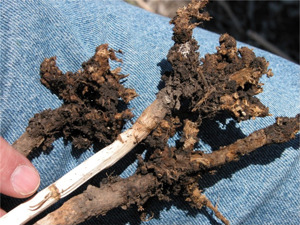
Features
Agronomy
Cereals
To bundle or not to bundle?
Consider agronomics when making crop input decisions.
March 5, 2008 By Top Crop Manager
There is no doubt that crop input rebates can add up. The manufacturer rebates can add up to $5 per acre or more, depending on the amount of seed, seed treatment, insecticides, herbicides and fungicides a farmer might use over the course of the year. For growers cropping 4000 acres that could mean a cheque for $20,000 – and it is usually delivered just before Christmas.
 |
| Good agronomics are important when considering the financial impact of bundles. Photo Courtesy Of Arysta LifeScience. |
“The cash is hard to ignore, especially for wheat growers who can only deliver 25 percent of the wheat with the first contract call. It’s like cash flow for them in the late fall,” says Steve Larocque, an independent crop consultant at Three Hills, Alberta. His company is called Beyond Agronomy and he works with a group of farmers in central Alberta to develop agronomic programs and solutions to crop production problems. Bundles are an irritant that he has to deal with.
The challenge with bundles is they may force a grower into a corner, especially with pesticide resistance. Larocque says that growers with wheat dominant rotations are more at risk, because they typically grow canola and then several years of wheat. This rotation relies on an in-crop wild oats herbicide, and since most bundles do not have anything but a Group 1
herbicide in their program for wheat, the risk is that Group 1 resistant wild oats populations may build up.
“The quandary that growers are put into is that if they select a Group 2 wild oats herbicide, they might be cutting themselves out of several thousands of dollars,” says Tony Zatylny, herbicide product manager with Arysta LifeScience at Calgary, Alberta. “It’s a tough decision, but agronomics have to take precedence over the long-term.”
Add a tight crop rotation and a large acreage farm into the mix, and the resistance to changing up herbicides is often great. Managing bundles comes down to knowing what is in the field and the field history. “For weed management, that means proper field scouting and good herbicide records,” explains Zatylny.
Larocque says seed treatments can be a problem with bundles, since some companies have just one seed treatment group. Used year after year, there is a possibility a pathogen that causes root rot could build up resistance to that seed treatment. Provincial Crop Protection Guides recommend rotating fungicide groups. Growers should consider rotating seed treatments and foliar applications between different groups.
Insecticide treatments could also suffer due to bundles. Some insecticides work better at lower temperatures while others work best at higher temperatures. As a result, the insecticide chosen is dependent on the time of day and the temperature, and might even change from hour to hour. That is no time to be making decisions based on rebates, since poor control could cost a lot more than a dollar per acre. And insecticides should also be rotated to prevent resistance build-up. “If you choose a seed treatment, herbicide, insecticide and a fungicide based on a program, you now could have sacrificed four areas of agronomy,” says Larocque.
Larocque says growers can often save as much money as they get on rebates by purchasing early. “If you look around at the end of the year in December, there can be some pretty good deals on pesticides. The money saved can be pretty significant and then you aren’t compromising the agronomics. It just takes some planning, knowing what is in your field and having the cash flow in the fall to take advantage of those discounts when they come up. That’s what I encourage my clients to do as much as possible.” -end-